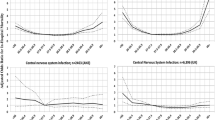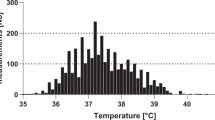Abstract
Fever is often the first sign of neutropenic infection, but its prognostic impact has not been established. We aimed to determine whether early peak temperature is associated with mortality in patients with neutropenic sepsis admitted to intensive care units (ICUs). We used a database of admissions to 157 ICUs in Australia and New Zealand between 2005 and 2013 to seek an association between peak temperature within the first 24 h in ICU and in-hospital mortality in neutropenic and non-neutropenic sepsis. Odds ratios for in-hospital death were calculated for four temperature bands, adjusting for illness severity. Two patient cohorts were identified: neutropenic sepsis (N = 4027) and non-neutropenic sepsis (N = 114,040). In-hospital mortality was higher in neutropenic sepsis than non-neutropenic sepsis. In both cohorts, early peak temperature below 36.5 °C was associated with significantly increased mortality compared to normothermia. Among non-neutropenic patients, an early peak temperature of 37.5 °C or higher was associated with reduced mortality compared to normothermia. In contrast, in patients with neutropenic sepsis, fever was not associated with reduced mortality compared to normothermia. Similar findings were seen in a subgroup of the neutropenic sepsis cohort with a documented haematological malignancy. In neutropenic sepsis patients admitted to ICU, a temperature below 36.5 °C is associated with increased mortality compared with normothermia. In contrast to non-neutropenic sepsis, fever was not associated with a significant reduction in mortality in neutropenic patients. Interventional studies are needed to determine whether physical or pharmacological measures to reduce fever influence outcomes during neutropenic infections.



Similar content being viewed by others
References
Bodey GP, Buckley M, Sathe YS, Freireich EJ (1966) Quantitative relationships between circulating leukocytes and infection in patients with acute leukemia. Ann Intern Med 64:328–340
Levy MM, Fink MP, Marshall JC et al (2003) 2001 SCCM/ESICM/ACCP/ATS/SIS international sepsis definitions conference. Crit Care Med 31:1250–1256
Penack O, Becker C, Buchheidt D et al (2014) Management of sepsis in neutropenic patients: 2014 updated guidelines from the Infectious Diseases Working Party of the German Society of Hematology and Medical Oncology (AGIHO). Ann Hematol 93:1083–1095
Legrand M, Max A, Peigne V et al (2012) Survival in neutropenic patients with severe sepsis or septic shock. Crit Care Med 40:43–49
Souza-Dantas VC, Salluh JI, Soares M (2011) Impact of neutropenia on the outcomes of critically ill patients with cancer: a matched case-control study. Ann Oncol 22:2094–2100
Kress JP, Christenson J, Pohlman AS et al (1999) Outcomes of critically ill cancer patients in a university hospital setting. Am J Respir Crit Care Med 160:1957–1961
Schellongowski P, Staudinger T, Kundi M et al (2011) Prognostic factors for intensive care unit admission, intensive care outcome, and post-intensive care survival in patients with de novo acute myeloid leukemia: a single center experience. Haematologica 96:231–237
Tam CS, O’Reilly M, Andresen D et al (2011) Use of empiric antimicrobial therapy in neutropenic fever. Australian Consensus Guidelines 2011 Steering Committee. Intern Med J 41:90–101
Weissinger F, Auner HW, Bertz H et al (2012) Antimicrobial therapy of febrile complications after high-dose chemotherapy and autologous hematopoietic stem cell transplantation-guidelines of the Infectious Diseases Working Party (AGIHO) of the German Society of Hematology and Oncology (DGHO). Ann Hematol 91:1161–1174
Freifeld AG, Bow EJ, Sepkowitz KA et al (2011) Clinical practice guideline for the use of antimicrobial agents in neutropenic patients with cancer: 2010 update by the Infectious Diseases Society of America. Clin Infect Dis 52:e56–e93
de Naurois J, Novitzky-Basso I, Gill MJ et al (2010) Management of febrile neutropenia: ESMO clinical practice guidelines. Ann Oncol 21(Suppl 5):v252–v256
Kwiatkowski D (1989) Febrile temperatures can synchronize the growth of Plasmodium falciparum in vitro. J Exp Med 169:357–361
Small PM, Tauber MG, Hackbarth CJ, Sande MA (1986) Influence of body temperature on bacterial growth rates in experimental pneumococcal meningitis in rabbits. Infect Immun 52:484–487
Knaus WA, Wagner DP, Draper EA et al (1991) The APACHE III prognostic system. Risk prediction of hospital mortality for critically ill hospitalized adults. Chest 100:1619–1636
Mackowiak PA, Marling-Cason M (1983) Hyperthermic enhancement of serum antimicrobial activity: mechanism by which fever might exert a beneficial effect on the outcome of gram-negative sepsis. Infect Immun 39:38–42
Su F, Nguyen ND, Wang Z et al (2005) Fever control in septic shock: beneficial or harmful? Shock 23:516–520
Brandts CH, Ndjave M, Graninger W, Kremsner PG (1997) Effect of paracetamol on parasite clearance time in Plasmodium falciparum malaria. Lancet 350:704–709
Graham NM, Burrell CJ, Douglas RM et al (1990) Adverse effects of aspirin, acetaminophen, and ibuprofen on immune function, viral shedding, and clinical status in rhinovirus-infected volunteers. J Infect Dis 162:1277–1282
Bow EJ, Rotstein C, Noskin GA et al (2006) A randomized, open-label, multicenter comparative study of the efficacy and safety of piperacillin-tazobactam and cefepime for the empirical treatment of febrile neutropenic episodes in patients with hematologic malignancies. Clin Infect Dis 43:447–459
Weinkove R, Clay J, Wood C (2013) Temperature management in haematology patients with febrile neutropenia: a practice survey. N Z Med J 126:62–73
Lee BH, Inui D, Suh GY et al (2012) Association of body temperature and antipyretic treatments with mortality of critically ill patients with and without sepsis: multi-centered prospective observational study. Crit Care 16:R33
Young P, Saxena M, Eastwood GM et al (2011) Fever and fever management among intensive care patients with known or suspected infection: a multicentre prospective cohort study. Crit Care Resusc 13:97–102
Young PJ, Saxena MK, Bellomo R et al (2012) The HEAT trial: a protocol for a multicentre randomised placebo-controlled trial of IV paracetamol in ICU patients with fever and infection. Crit Care Resusc 14:290–296
Schortgen F, Clabault K, Katsahian S et al (2012) Fever control using external cooling in septic shock: a randomized controlled trial. Am J Respir Crit Care Med 185:1088–1095
Mourvillier B, Tubach F, van de Beek D et al (2013) Induced hypothermia in severe bacterial meningitis: a randomized clinical trial. JAMA 310:2174–2183
Stow PJ, Hart GK, Higlett T et al (2006) Development and implementation of a high-quality clinical database: the Australian and New Zealand intensive care society adult patient database. J Crit Care 21:133–141
Australian and New Zealand Intensive Care Society (2013) Centre for outcome and resource evaluation annual report 2011–12. In. Melbourne: Australian and New Zealand Intensive Care Society
Young PJ, Saxena M, Beasley R et al (2012) Early peak temperature and mortality in critically ill patients with or without infection. Intensive Care Med 38:437–444
Paul E, Bailey M, Pilcher D (2013) Risk prediction of hospital mortality for adult patients admitted to Australian and New Zealand intensive care units: development and validation of the Australian and New Zealand risk of death model. J Crit Care 28:935–941
Dellinger RP, Levy MM, Rhodes A et al (2013) Surviving sepsis campaign: international guidelines for management of severe sepsis and septic shock: 2012. Crit Care Med 41:580–637
Dzarr AA, Kamal M, Baba AA (2009) A comparison between infrared tympanic thermometry, oral and axilla with rectal thermometry in neutropenic adults. Eur J Oncol Nurs 13:250–254
Farnell S, Maxwell L, Tan S et al (2005) Temperature measurement: comparison of non-invasive methods used in adult critical care. J Clin Nurs 14:632–639
Bain B (2006) Blood cells: a practical guide. Blackwell Publishing Ltd, Oxford
Bodey GP, Rodriguez V, Chang HY, Narboni (1978) Fever and infection in leukemic patients: a study of 494 consecutive patients. Cancer 41:1610–1622
Feld R, DePauw B, Berman S et al (2000) Meropenem versus ceftazidime in the treatment of cancer patients with febrile neutropenia: a randomized, double-blind trial. J Clin Oncol 18:3690–3698
Bow EJ (2013) Infection in neutropenic patients with cancer. Crit Care Clin 29:411–441
Jefferies S, Weatherall M, Young P et al (2011) The effect of antipyretic medications on mortality in critically ill patients with infection: a systematic review and meta-analysis. Crit Care Resusc 13:125–131
Young PJ, Bellomo R (2014) Fever in sepsis: is it cool to be hot? Crit Care 18:109
Acknowledgments
We wish to thank the Australian and New Zealand Intensive Care Society Centre for Outcome and Resource Evaluation Management Committee for reviewing the study protocol. This work was supported by the Health Research Council of New Zealand (grant number 13/699 to RW).
Conflict of interest
The authors report no conflicts of interest.
Author information
Authors and Affiliations
Corresponding author
Electronic supplementary material
Below is the link to the electronic supplementary material.
Appendix S1
(DOCX 90 kb)
Appendix S2
(DOCX 115 kb)
Appendix S3
(DOCX 83 kb)
Rights and permissions
About this article
Cite this article
Weinkove, R., Bailey, M., Bellomo, R. et al. Association between early peak temperature and mortality in neutropenic sepsis. Ann Hematol 94, 857–864 (2015). https://doi.org/10.1007/s00277-014-2273-z
Received:
Accepted:
Published:
Issue Date:
DOI: https://doi.org/10.1007/s00277-014-2273-z




